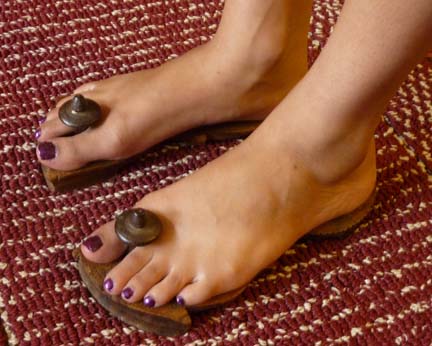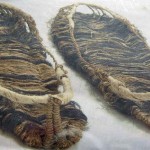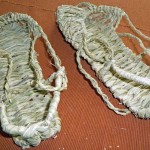About ten years ago, Korean archaeologists exhumed the partially mummified remains of Eung-tae, a male member of an ancient clan. The tomb was dated to the mid to late 1500s. It contained articles of clothing and writings, including letters and poems. Hyung-eun Kim wrote a very interesting article about this family of mummies entitled “Korean Love Affair” for Archaeology magazine. Of particular interest to the Straw Sandals Project was the discovery of a pair of sandals made of human hair in Eung-tae’s tomb. They were wrapped in a paper package and placed by his head. It is thought that his widow may have made them using her own hair. Readers of the article will be rewarded with many details and images of this find. It is stated in the article that Korean literature contains references to the practice of using human hair to craft shoes to symbolize love or hope for recovery from sickness. These sandals, shown below on the left, are the first known examples. The second image, shown below on the right, is from the Straw Sandals Collection. I photographed item K1 from the same perspective as the image of the Korean hair sandals. K1 are contemporary straw sandals that I purchased from a seller in South Korea. They are the same style of sandal as the ancient hair sandals from Eung-tae’s tomb. This then is an example of an old weaving design that has persisted into the present. (Click on images to enlarge)
Author Archives: Joan
Announcing The Seated Dancer Poetry Prize Winner
It is my pleasure to announce the First Prize Winner of the Seated Dancer Poetry Contest of 2011. The winning Diamante Poem was submitted by Megan Moody, Enrico Fermi High School, Enfield, Connecticut. The poem entitled “Two in One” is presented here in both Latin and English. For additional information see “The late Antique Silver Dancer in Boston”, a paper by Marice Rose in the New England Classical Journal v. 37.3 (2010) pp. 177-191. Also there is some interesting video on our Facebook page (About>Resources>Links) about the close relationship between dancers and their shoes.
DUAE IN ŪNĀ
Ancilla
indocta dūra
cōgor labōrō patior
Calceōs et crotala induō.
Tandem ea dēpōnō, dēfessa.
exspectant haurior laudant
fēminea gracilis
Saltātrīx
TWO IN ONE
Slave-woman
illiterate enduring
I’m forced, I work, I suffer
I put on my slippers and castanets.
Finally I take them off, exhausted.
they anticipate, I’m swallowed up, they praise
feminine delicate
Dancer
 Image licensed from the Museum of Fine Art, Boston, MA.
Image licensed from the Museum of Fine Art, Boston, MA.
Why miniature shoes?
I have had several inquires asking the question Why have you started adding miniature shoes to the collection? I have found that they ‘inform” the straw shoes and sandals in several ways. Miniature M3 is an example. It has essentially the same design as straw shoe C15. A tag on the bottom of each C15 shoe indicates each was made in China but it is not clear whether the design is contemporary or ancient. The same design of the antique miniature makes it likely that the design has been around in China for a long time.
Another reason is that the miniatures are beautifully crafted and often inscribed with images that enrich our appreciation for and understanding of the culture. For example, see the description below of the fish net design on the top front of shoe M3.
See the gallery below for illustration:
Straw Sandals Project on Facebook
The SSP Facebook page (see also the Links page under About>Resources>Links) features several videos showing the special relationship between humans and footwear. For example the effect of new red dancing shoes on the dancer in the YouTube video Tanzschule is shown beautifully. We are left to imagine what the dancer is thinking and feeling. The same may be said for the Seated Dancer in an old Roman statuette from the late third or early fourth century A.D.

Antique Padukas Arrive
A pair of antique sandalwood padukas most likely made in India were bought for the collection on Ebay recently. The seller stated that they were purchased at a “suq” in Saudi Arabia in the mid 1980s. The age and origin of these padukas are not documented but they are the style make in India for millennia. They are currently being studied and have been entered into the collection as item I1. One of the things I noticed is that the padukas fit an Indian female foot perfectly. I have begun searching for examples of women (or a female form) in India wearing wooden padukas and they are rare. I found one example in a YouTube video that I have posted on the Straw Sandals Project Facebook page. I think it is the Hindu Goddess of Power and Energy, Durga Maa, wearing them. To see the video (the music is beautiful) go to About>Resources>Links>SSP Facebook link.
Latest straw shoes for collection from Ruixing Lu
Recently, I received a message from Ruixing Lu that he found some baby straw shoes at The Straw Articles store near Chenghuang Temple in Yuyuan Garden, Shanghai. The shoes were made in a Shanghai suburb and are contemporary. Thanks to Luki, my translator, we know that Ruixing wrote “囡囡小草鞋” as the topic. “囡” is in the Wu dialect. It is a nickname for little kids. Ruixing created a link for us to get a preview of the new items. The Wu dialect is spoken in an around Shanghai. It has properties of a separate language but is considered in China to be a dialect of Chinese. If you would like a brief introduction of this ancient dialect, Luki provided a link here. The shoes are now in the Collection and are labeled C17 and C18.
In addition, Ruixing sent two pairs of womens’ sandals found in a suburb of Wuxi. They date back to the 1920s. We know this because these sandals were found in a closet with old letters, wedding invitations and other items in the attic of an old Wuxi building during the demolition of the Zhengxing Road in March of 2010. They are now in the Collection as items C19 and C20.
Are you looking for 8300 years old Huarachis?
A woven sandal from a cave in Missouri has been dated to 8300 years old. It was made from the leaves of a yucca-like plant with the common name rattlesnake master. The sandal is surprisingly similar in design to modern Huarachi shoes from Mexico. The story was featured in the New Scientist in the link below:
http://www.newscientist.com/article/mg15921422.300-secondhand-shoes.html
The accelerator mass spectrometer dating was done by Michael J. O’Brien and colleagues and appeared in a 1998 report in Science titled “7500 Years of Prehistoric Footwear from Arnold Research Cave, Missouri“.
The Fort Rock Sandal
Discovered by Luther S. Cressman in 1938, this approximately 9,000 years old sandal from Fort Rock Cave is an important piece of the prehistory of Oregon Indians. Cressman (1897-1994) was a pioneering field archaeologist at the University of Oregon. He recovered about 75 sandals made from sagebrush bark cords from Fort Rock Cave along with other artefacts that suggest human occupation 12,000-10,000 years ago. Additional Fort Rock-style sandals have been recovered from Cougar Mountain and Catlow caves and these have been directly dated to 10,500-9300 years old.
http://www.uoregon.edu/~connolly/FRsandals.htm
A nice companion to the website above is Luther Cressman’s little book “The Sandal and the Cave”, ISBN 0-87071-059-1, Oregon State University Press.
Moving Millions
The subtitle of this new book by Jeffrey Kaye is “How Coyote Capitalism Fuels Global Immigration”. The term coyote capitalism encapsulates the practice of some businesses and governments that treats humans like a natural resource, to be moved about internationally like shipping containers to meet labor demands. In the context of the Straw Sandals Project, we have here great contemporary stories that emphasize the continuing saga of human migration.
John Wiley & Sons, Inc., 2010, ISBN: 978-0-470-42334-9.
Tendai Monk Walks a Distance Equal to a Circumnavigation of the Earth in Straw Sandals
In this NPR story, writer Anthony Kuhn tells the story of Endo Mitsunago, a 34-year-old Japanese monk, who walked, mediated and prayed over a period of seven years. During this time in he made 1,000 walks in straw sandals around Mount Hiei.
The story title “A Monk’s Enlightenment Begins with a Marathon Walk” is at the link below:
http://www.npr.org/templates/story/story.php?storyId=125223168






